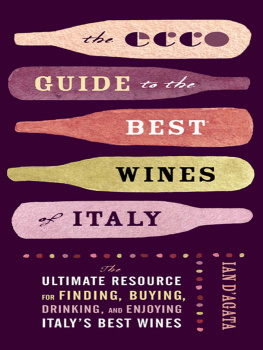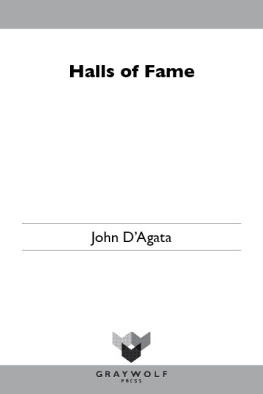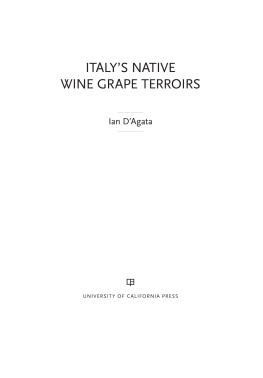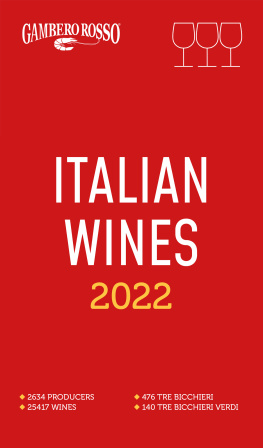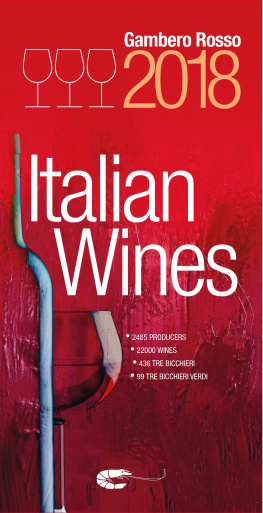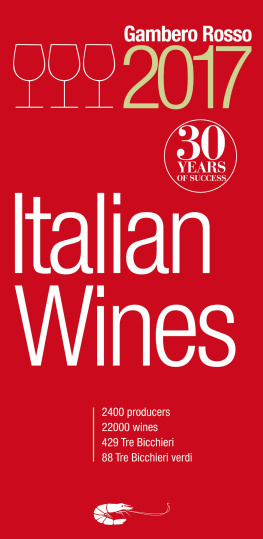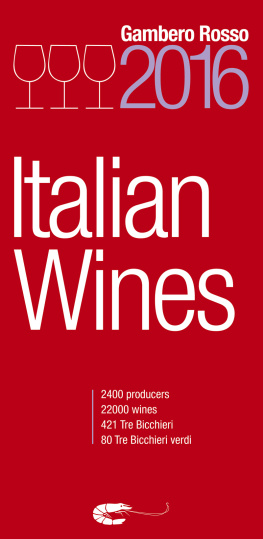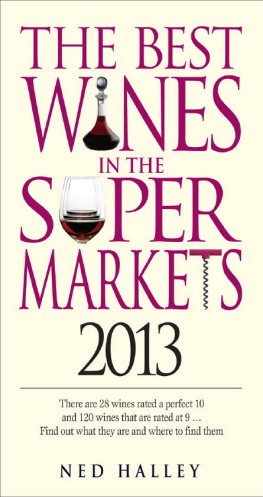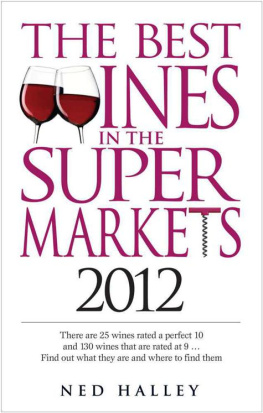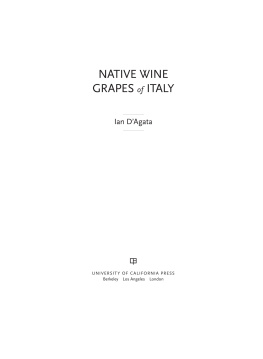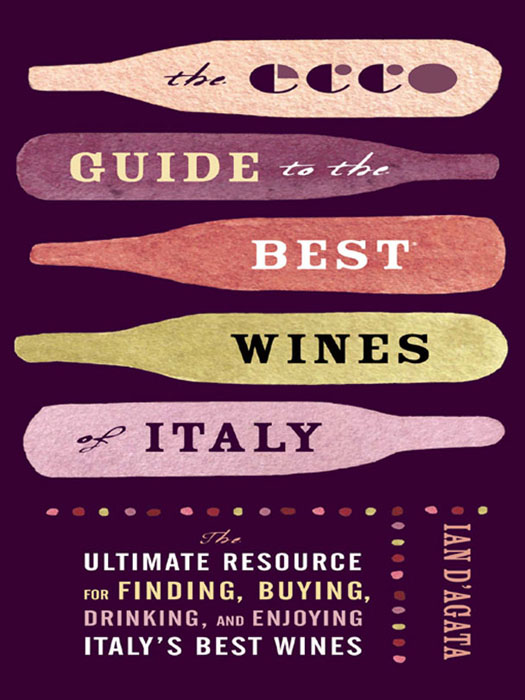I HAVE BEEN DRINKING WINE FOR LONGER than my mother cares to remember. If you know anything about Italian families in general, and Italian mothers in particular, then you also know that their opinions carry considerable weight. I am still trying to convince my mother that writing about wine is a time-honored, respectable profession.
In the 1970s my family moved from Italy to Toronto, where my father, an Italian psychiatrist in love with the open spaces and wonderful outdoors of North America, had accepted a post at a local hospital. Italian patients are the best the medical profession can wish for, as they have a truly endearing habit of inundating their doctors with all sorts of gifts come Christmastime, bottles of wine being foremost among these. However, even though we had a treasure trove of wine in our cellar, we rarely drank any, because my father, who liked wine, had seen too many families ruined by alcoholism and didnt want us drinking wine regularly. Thus, I had never really tasted any wine memorable enough to make wines seem interesting to me.
Then it happened. On a sunny day in the summer of 1979 a few teenage friends sitting around a pool wanted to drink wine and asked me to open a bottle of the Italian stuff, and so off I went to the cellar. I didnt know what I was doing, but remembering that my father had always spoken well of Barolo and Gattinara, I reached for a Barolo 1971, whichalthough this was completely unknown to mewas an absolutely stellar vintage. One taste and I was blown away: it was a true case of love at first sight, a love affair from which I have never recovered. The very next day I met one of those friends at his house, where I tried a 1976 Mulheimer Helenkloster Riesling Eiswein, to this day still one of the most enjoyable Eisweins that have ever graced my lips. After those two encounters, my life has never been the same. I began studying wine, reading about it, attending wine lectures and tastings, spending every penny I had, as a student, to buy wines from all over the world, and of course tasting, tasting and more tasting. In short, by the time I was 22 years old I had already tasted through thousands of wines not just from Italy but around the world. I was fortunate to begin my wine training with fine teachers of English origin (Britain has always had the best wine schools) and the large selection of fine wines to choose from at the Liquor Control Board of Ontario (LCBO), a state-run monopoly that remains the single largest wine buyer in the world. So it was easy to taste the best wines, not just from Italy but from Australia, California, and elsewhere; still, when I moved back to Italy after high school, Italian wines became my passion. In fact, Italys wines didnt seem inferior to the worlds greatest. As great as French wines were, Italys grape varieties and wines also held impressive potential: nebbiolo, aglianico, sangioveseAlthough these wines may not (at least not then) have been technically perfect like the best from France, they had soul and a sense of place and tradition, traits I still look for in my wines today. In todays world of overly alcoholic, way too tannic behemoths, and of wine making by the numbers with wines all too similar no matter where they come from, its good to know that most Italian wines still have a certain somewhereness. They talk to you about specific people and century-old traditions, and they go marvelously well with food.
Like almost everyone else who writes professionally about wine today, I too started out on a different path: I hold a degree in medicine. My love of wine, something I had studied and written about prior to undertaking medical studies, led me to give up the operating room and incur the incredulity and wrath of my mother, who couldnt believe her son would give up a career because of wine. After more than 25 years of writing and talking about wine all over the world, I am proud to write this new guide to Italys best wines, made possible by the visionaries at Ecco, a publishing house with a long history of the very best in everything gastronomic. Even my mother is happy about it. Oh, I almost forgot: I dedicate this guide to her, so that she may see it wasnt all a huge mistake after all.
I AN DA GATA
ITALY IS THE PLACE FOR WINE. NOT BY CHANCE was its ancient name Oenotria, the land of vines or, according to some experts, the land of vines trained to poles. Back then it was already apparent that the best wines were produced from vines supported by poles rather than from vines running wild around trees or other natural supports (the foliage creating shade and not allowing for proper ripening of the grapes). This tells you something about how seriously wine production has always been taken here. In fact, one of Italys many native grape varieties is schiava, or female slave; the name refers to its being enslaved by being tied down to a pole or cane, and documents from ancient Roman times inform us that land cum vitis sclavis with enslaved vineswas worth four times as much as land on which the grapes were allowed to grow without such help.
Wine permeates every aspect of Italian life and society. Children begin drinking early; old-timers get together in the main village square to play cards and have a glass of wine; and if you show any interest whatsoever in wine when dining at an Italians house, the host will be sure to offer you a taste of his own special wine. The wine is special in that its made by him or a relative or a farmer he swears by, and not because of any particularly redeeming feature, so youre left to imbibe at your own risk and peril. Once youve tasted the artisanally made potable, you may find yourself wishing you had kept your mouth shut, but that is another matter altogether. Its the enthusiasm about wine here that counts.
Italy is the single country where youll find the largest number of varieties of wine grapes. At last count, there were roughly 2,500, depending on who was doing the counting. Italians cling ferociously to what they perceive as their grapes and dont care to hear about the latest DNA analysis that might prove their grape identical to a grape grown somewhere else. In fact, only half of Italys 2,500 grapes have been genetically identified, and of these, only about 600 are being used to make wine in commercially important amounts. Still, if Italy is offering wine lovers everywhere wines made from 600 varieties, plus all the possible blends thereof (and you know how creative Italians can be), you realize that no other place in the world can offer a similar plethora of fragrances and flavors. If you stop to think that about 99% of all French wines are made from 15 grape varieties, and that about 99% of all California wines are made from perhaps seven varieties, you realize how varied Italys wines can be. In Italy there is no need for ABC clubsthose groups of wine lovers who are so bored with chardonnay and cabernet that theyll drink Anything But Chardonnay or Anything But Cabernet! Of course, this seemingly never-ending litany of grapes and wines makes for a highly confusing situation, and the fact that Italian wine labels seem purposely designed to further confuse is only part of the problem. Its one thing to read Merlot or Chardonnay on a label, as you know, more or less, what you might be getting. Its quite another to read Pallagrello Bianco, Cannonau, or Nero dAvola. The following pages aim to help you make sense of the wonderful world of Italian wines.
AT THE DAWN OF THIS PROJECT, I SET OUT TO write the guide to Italys wines that I had always longed for but had searched for in vain. The fact is that choices are few when it comes to books dealing with Italian wines. Most books currently available are not wine- or vintage-specific, are only sporadically updated, and focus only on the more important wine production areasgiving little advice on buying the wines of other regions, for which the content is limited to a few of the better-known producers. Further compounding the problem is Italys inherently difficult wine scene, with byzantine laws, a plethora of often obscure grape varieties, and new producers emerging all the time. The very nature of Italian wine, with countless wine-producing areas and estates, makes writing a comprehensive book on the subject a daunting task; and the book itself runs the risk of being much too long, and neither useful nor interesting. Therefore, I have deliberately set out to write a guide that gives a complete overview of Italys best wines, with enough wines included so that the picture you get is accurate and thorough, but without turning it into a telephone book or an encyclopedia. Furthermore, in an effort to avoid frustration on the part of both reader and wine buyer, I have devoted Section I to wines that cost $100 or less, are imported into the United States, and (with few exceptions) are made in large enough quantities so that you ought to be able to find them in wine shops.

